
|
IAAC ERASING BORDERS FESTIVAL OF INDIAN DANCE INDOORS Dance Concert: August 28th, 2015. 7-9pm Schimmel Auditorium, Pace University, NYC An Evening of "Poetry, danced" |
|
| highlighting the literary content and languages of Indian classical dance repertoire | |
| Click here for MAP and DIRECTIONS | |
| Indoors: $35.00 General Admission, $30 IAAC members Friday, August 28, 2015 from 7:00 PM to 9:00 PM  |
|
| 1. AISHWARYA BALASUBRAMANIAN in Bharatanatyam (from temples of Tamilnadu) | |
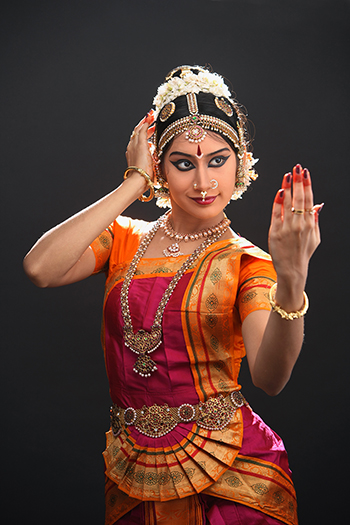 is the senior-most student of Guru Acharya Choodamani Smt. Anitha Guha, with whom she began studying - and performing - at early age, stunning audiences with her grace, clarity of footwork and beauty of expression. Aishwarya is now among Chennai's most popular Bharatanatyam dancers, as witnessed by the many awards she has received from eminent cultural organizations of south India. Her dance school 'Arpanam' in New England is a branch of her guru's Bharatanjali.
is the senior-most student of Guru Acharya Choodamani Smt. Anitha Guha, with whom she began studying - and performing - at early age, stunning audiences with her grace, clarity of footwork and beauty of expression. Aishwarya is now among Chennai's most popular Bharatanatyam dancers, as witnessed by the many awards she has received from eminent cultural organizations of south India. Her dance school 'Arpanam' in New England is a branch of her guru's Bharatanjali.
|
|
| Ajapa Natanam 'dance of the unuttered prayer' (16:30) [Varnam: verses in Telugu] is said to be performed by Shiva in his form as Somaskanda (with wife Uma and son Skanda) in the temple of Vishnu at Thiruvarur. In the two main lines - pallavi and anupallavi - of the poem dedicated to this yogic form of Shiva, he is first addressed as a lover and asked to come quickly to her, and then described as the awe-inspiring deity seen in procession around the magnificent shrine. |
|
| 2. PALLAVI KRISHNAN in Mohiniyattam (from temples of Kerala) | |
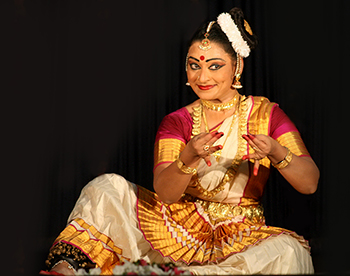 A leading Mohiniyattam exponent, Pallavi is acclaimed for her versatility as performer, choreographer and teacher. Having trained in Mohiniyattam with Guru Kalamandalam Shankaranarayanan, she graduated in Dance/Kathakali at Shantiniketan - the only Indian dancer who is an alumnus of both of these legendary arts academies. Equally proficient in adavu (technique) and abhinaya (facial expression), she performs and teaches all over the world, and has received several honors for her contributions to Mohiniyattam and its repertoire.
A leading Mohiniyattam exponent, Pallavi is acclaimed for her versatility as performer, choreographer and teacher. Having trained in Mohiniyattam with Guru Kalamandalam Shankaranarayanan, she graduated in Dance/Kathakali at Shantiniketan - the only Indian dancer who is an alumnus of both of these legendary arts academies. Equally proficient in adavu (technique) and abhinaya (facial expression), she performs and teaches all over the world, and has received several honors for her contributions to Mohiniyattam and its repertoire.
|
|
| Pingala (14:30) [lyrics in Malayalam] Inspired by a poem in Malayali by mid 20thC Kerala poet Ulloor S. Parameswara Iyer, the dance depicts a courtesan, who transcends her worldly life because of spiritual revelation. We first see the beautiful Pingala awaiting her wealthy clients, confident of her prowess to lure men. Her haughtiness turns to anxiety and despair, as she realizes that she only valued her clients for their wealth. Thinking of the ephemeral nature of physical beauty and riches, she finds solace - and redemption - by focusing instead on Lord Rama, chanting his name and thinking of him, until she eventually attains moksha (release, salvation). |
|
| 3. RAKESH SAI BABU in Chhau (from Mayurbhanj, Orissa) | |
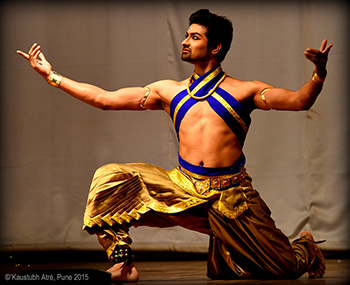 Born into the royal family of Mayurbhanj (Orissa) renowned for its performance-cum-martial art, Rakesh belongs to the Gurukul Chhau Dance Sangam, a company of six dancers directed by his father and renowned for both traditional and innovative works. Versed in a range of dance forms, he has also choreographed musicals, stage shows and television specials. His primary mission, however, is to promote Mayurbhanj Chhau, through performances and workshops around India - and the world. Born into the royal family of Mayurbhanj (Orissa) renowned for its performance-cum-martial art, Rakesh belongs to the Gurukul Chhau Dance Sangam, a company of six dancers directed by his father and renowned for both traditional and innovative works. Versed in a range of dance forms, he has also choreographed musicals, stage shows and television specials. His primary mission, however, is to promote Mayurbhanj Chhau, through performances and workshops around India - and the world. |
|
| Nataraja (10:00) [chants in Sanskrit] Shiva's dance of bliss, his 'Anandatandava,' symbolizes the cosmic cycles of creation and destruction, found also in the rhythm of human birth and death. The dance is a visual allegory of the five principal manifestations of energy - creation, destruction, preservation, salvation, and illusion - expressed especially in the innumerable verses in Sanskrit we hear chanted all over India in temple ceremonies - and in household prayer. |
|
| 4. APARUPA CHATTERJEE - Odissi (from temples of Orissa) | |
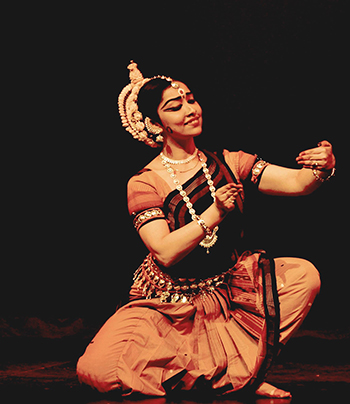 Aparupa Chatterjee is a leading disciple of gurus Ratikant and Sujata Mohapatra and their school Srjan in Orissa, who has received several awards in her native India. Now based in Texas, and after a PhD on the role of performing arts in international development, she founded the International Institute for Culture and Performing Arts Development, and is curator-organiser of the North American Odissi Convention. Her Odissi Dance Company recently featured in season 10 of America's Got Talent. Aparupa Chatterjee is a leading disciple of gurus Ratikant and Sujata Mohapatra and their school Srjan in Orissa, who has received several awards in her native India. Now based in Texas, and after a PhD on the role of performing arts in international development, she founded the International Institute for Culture and Performing Arts Development, and is curator-organiser of the North American Odissi Convention. Her Odissi Dance Company recently featured in season 10 of America's Got Talent. |
|
| Brajaku chora . . . (9:00) [Oriya Geet - folk song] “Go to sleep you naughty child, or else . . . the thief who searches for kids not yet asleep with come for you." In this endearing song from Oriya folk tradition, Mother Yashodha tries to put her reluctant child Krishna to sleep, by attempting to scare him with tall tales of the fate that befalls those children who are still awake. Himself a prankster, the Lord is not fooled. The ruling emotion of the abhinaya is 'vastalya' rasa - maternal love - in contrast to the romantic love of most poetry that is danced. |
|
| 5. SANJUKTA WAGH- Kathak (from north Indian temples and courts) | |
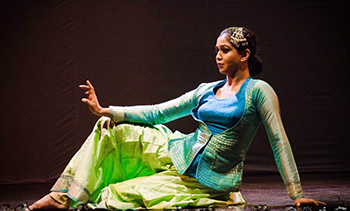 Performer, choreographer, teacher and curator, Sanjukta Wagh trained extensively in Kathak with Rajashree Shirke in Hindustani music with Murli Manohar Shukla. Her engagement with theatre, sojourn at London's Laban Centre, love of literature and deep unease with comfort zones, have led to an interdisciplinary mode of performance. Both her innovative works and traditional Kathak have won applause around India and abroad. Her dance-theatre piece, Rage and Beyond: Irawati's Gandhari won two Mahindra Excellence in Theatre Awards in 2015.
Performer, choreographer, teacher and curator, Sanjukta Wagh trained extensively in Kathak with Rajashree Shirke in Hindustani music with Murli Manohar Shukla. Her engagement with theatre, sojourn at London's Laban Centre, love of literature and deep unease with comfort zones, have led to an interdisciplinary mode of performance. Both her innovative works and traditional Kathak have won applause around India and abroad. Her dance-theatre piece, Rage and Beyond: Irawati's Gandhari won two Mahindra Excellence in Theatre Awards in 2015.
|
|
| Orange butterflies and aqua sequins (14:00) [Ntozake Shange poem in English] an excerpt from beej's "let her be born": a tribute to women artistes around the world through poetry, music and dance. Inspired by Ntozake Shange's choreo-poem “for colored girls who have considered suicide when the rainbow is enuf”, the choreographer visualized this "passion flower of south west Los Angeles" in the lanes of Benaras and longed to dance her in Kathak, in particular because she was not a stereo-typical 'nayika' (heroine) of classical Indian poetry, who simply yearns for her beloved - but, instead, represented voice of strong women from all over the globe. |
|